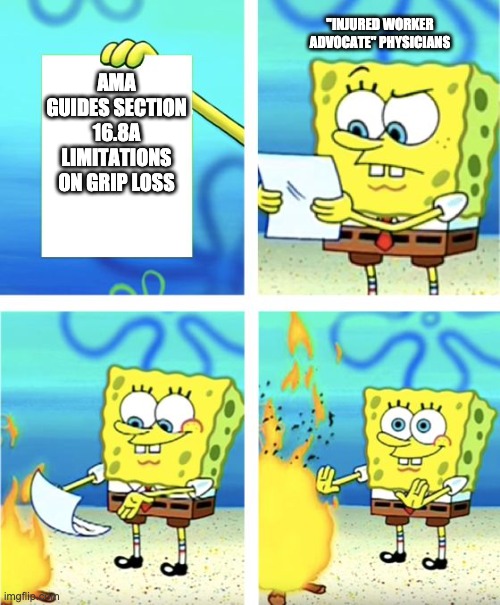Well, it’s Monday again, dear readers. Are you ready to get back to work?
Despite the activity in the news, workers’ compensation is a constant. Weather, COVID19, politics… these things are all temporary. But workers’ compensation is forever. Long after the sun has gone super nova and all trace of mankind has vanished, there will still be UR denials and panel litigation. Don’t ask me how – it is the magic of the Workers’ Compensation laws.
With that hopeful tone to cheer us on, let’s talk about one of the more frustrating aspects of the AMA Guides – grip loss! The AMA Guides allow a rating impairment for grip loss in “rare” cases where the evaluator believes the loss of strength is not represented adequately by other rating factors. This is supposed to be strictly limited by the Guides in section 16.8a on page 508: “Decreased strength cannot be rated in the presence of decreased motion, painful conditions, deformities, or absence of parts (eg, thumb amputation) that prevent effective application of maximal force in the region being evaluated.” (Emphasis original).
Well, if you have an applicant-oriented or pro-applicant biased PQME, these restrictions don’t really matter.

Despite all the hoopla and dressing, grip loss is inherently subjective. If the PQME decides to copy-paste the text “the applicant demonstrated full effort during grip loss test,” then the inherently subjective “best effort” is still subjective. But if your evaluating physician isn’t aware that grip loss isn’t a freebie, or if your evaluating physician doesn’t care that it’s not a freebie, you might see grip los added to all sorts of conditions. Can you imagine getting a rating for a hand amputation, but then having the QME add a grip loss impairment? Crazy, no? If an applicant’s shoulder hurts after surgery, odds are the full strength will not be on display for a grip loss test either.
Well, recently a case originating in Sacramento came before the WCAB, Minniefield v. Dept’ of Corrections Inmate Claims. Applicant, an inmate, sustained a shoulder injury that underwent surgical intervention. In finding the injured worker P&S, the PQME also assigned shoulder impairment based on lost range of motion (21% UEI), distal clavicle resection (10% UEI), and 17% UEI based on loss of strength.
In the same report, the PQME found that the strict rating most accurately described the applicant’s impairment, and so an Almaraz/Guzman rating was not necessary.
Well, the strict rating doesn’t allow for a rating of grip loss “in the presence of decreased motion” and there’s no other rating. In granting defendant’s petition for reconsideration, the WCAB returned the matter to the trial judge with instructions to further develop the record to obtain a report that is substantial medical evidence.
Specifically, the guidance of the WCAB was to check off the following to-do list to complete the record: (1) obtain a strict AMA Guides rating; (2) explain why the strict rating doesn’t accurately reflect the applicant’s disability; (3) provide an alternative rating under Almaraz/Guzman; and (4) explain why the alternative rating more accurately reflects the applicant’s level of disability.
This doesn’t really help defendant in this case – a competent cross examination will help the PQME cure any defects in the report, and the ultimately result will likely be the same level of disability only under Almaraz/Guzman rather than the AMA Guides. In fact, the final report will likely look something like this: AMA Guides – range of motion and surgical result; Almaraz/Guzman – add on the grip loss.
But, such a defect in a report and the resulting finding that the report is not substantial medical evidence can help in some cases. Sometimes buying time for the defense can gain a tactical advantage because of other circumstances, such as giving applicant more time to heal or an intervening injury providing an additional defendant.
Further, if the record consists of a PTP report that is more conservative but is without defect, then, presumably, there is no need to develop the record as the treating physician’s PR-4 can be the basis of an Award.
So if you’re faced with a rating inflated by grip loss, take a close look at 16.8a and see if the physician issuing the rated report complied fully with the requirements of the AMA Guides. It looks like the WCAB is at least somewhat receptive to arguments when such reports come up short.
